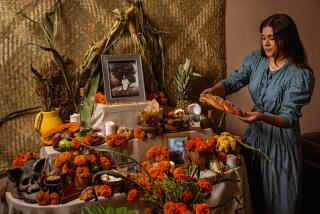The Day of the Dead
- Share via
First-time visitors to the folk art gallery were shocked to see altars holding toy coffins, small skulls with names on them and miniature cadavers dancing and playing in a band. The patrons complained that the objects were distasteful and gruesome. The curator explained that the altars were part of the Day of the Dead (Dia de los Muertos) observance and an integral part of the Mexican life cycle. The celebration allows people, especially children, to become familiar with death through the display of its symbols.
On Day of the Dead, which is popularly observed in Mexico on All Soul’s Day, Nov. 2, many people believe that the deceased return to their homes to be with the living. Families welcome them by creating altars holding the deceased’s photo, favorite foods and objects--sometimes including unexpected items such as cigarettes, liquor or a deck of cards--displayed alongside flowers, candles, religious figurines and Day of the Dead bread decorated with skulls and crossbones.
Day of the Dead celebrations have crossed the border, sometimes resulting in an American twist. One young woman created an altar for her cat, Pogo, who had been eaten by a coyote. She displayed Pogo’s toys, photos taken with him, the doll’s crib and fancy pillow where he napped and drawings she had made of him when she was 7 years old. Children who saw the altar easily related to the tragedy of Pogo’s demise.
The Folk Tree in Pasadena is sponsoring a free altar exhibit through Nov. 2. For information, phone (626) 795-8733.
More to Read
Sign up for Essential California
The most important California stories and recommendations in your inbox every morning.
You may occasionally receive promotional content from the Los Angeles Times.










